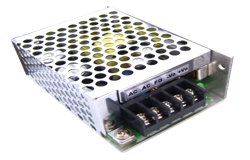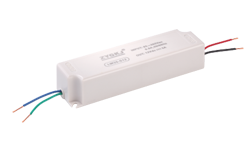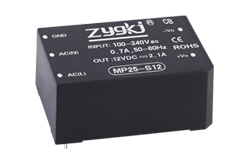nouvelles
Designing an AC-DC Converter Circuit
Auteur: Module d'alimentation ZYG Time: 2023-5-6
An AC-DC converter circuit is an essential component in many electronic devices. It is a device that converts alternating current (AC) to direct current (DC). This circuit is commonly used in power supplies for electronic devices, such as laptops, smartphones, and other household appliances. In this article, we will discuss the basic components of an AC-DC converter circuit and the steps involved in designing one.
Basic Components
The basic components of an AC-DC converter circuit include a transformer, rectifier, filter, and regulator. The transformer is used to step down the AC voltage to a lower value. The rectifier converts the AC voltage to DC voltage. The filter removes the unwanted AC components from the DC output, and the regulator is used to regulate the DC output to a constant value.
Design Steps
The following steps are involved in designing an AC-DC converter circuit:
1. Determine the output voltage and current requirements: The first step is to determine the required output voltage and current for the device. This will help in selecting the appropriate transformer and regulator for the circuit.
2. Select the transformer: The transformer is used to step down the AC voltage to a lower value. The primary winding of the transformer is connected to the AC source, and the secondary winding provides the stepped-down voltage. The voltage ratio of the transformer is determined by the number of turns in the primary and secondary windings. The transformer should be selected based on the required output voltage and current.

3. Select the rectifier: The rectifier is used to convert the AC voltage to DC voltage. There are two types of rectifiers: half-wave rectifier and full-wave rectifier. The half-wave rectifier is the simplest rectifier, but it has low efficiency. The full-wave rectifier is more efficient and provides a smoother DC output. The rectifier should be selected based on the required output voltage and current.
4. Select the filter: The filter is used to remove the unwanted AC components from the DC output. The filter can be a capacitor or an inductor. The capacitor filter is commonly used in low-power applications, while the inductor filter is used in high-power applications. The filter should be selected based on the required output voltage and current.
5. Select the regulator: The regulator is used to regulate the DC output to a constant value. There are two types of regulators: linear regulator and switching regulator. The linear regulator is simpler but less efficient, while the switching regulator is more complex but more efficient. The regulator should be selected based on the required output voltage and current.
6. Build and test the circuit: Once the components are selected, the circuit can be built and tested. The circuit should be tested for its output voltage, current, and efficiency.
Conclusion
Designing an AC-DC converter circuit involves selecting the appropriate transformer, rectifier, filter, and regulator based on the required output voltage and current. The circuit should be built and tested for its output voltage, current, and efficiency. An efficient and reliable AC-DC converter circuit is essential for the proper functioning of many electronic devices.
Précédent: AC-DC Converter Module: Efficient Power Conversion Solution
Prochain: AC-DC Power Supply: Efficient and Reliable Energy Conversion Solution
les informations pertinentes
-
2023-9-19
DC Power Supply Module: Delivering Reliable and Efficient Power Solutions
Introduction: Where electronic devices have become an integral part of our daily lives, the need for a reliable and efficient power supply has never been greater. Whether it is for industrial applications, telecommunications, or consumer electronics, the DC power supply module plays a crucial role in delivering the necessary electricity to ensure the smooth functioning of these devices. This article aims to explore the importance of DC power supply modules, their features, and their applications. Importance of DC Power Supply Modules: A DC power supply module is a device that converts alternating current (AC) into direct current (DC) and regulates it to deliver a stable and constant voltage or current output. It acts as a backbone for various electronic systems...
Voir les détails -
2023-7-27
Is the DM Series DC DC Power Supply being introduced to unleash optimal performance?
In today's fast-paced technological world, reliable and efficient power supply solutions are essential for maximizing performance and ensuring the smooth operation of various electronic devices. With this in mind, we are thrilled to introduce the revolutionary DM Series DC DC Power Supply, designed to unleash optimal performance like never before. At the heart of the DM Series is cutting-edge technology that sets it apart from the competition. This power supply boasts advanced digital control algorithms, allowing for precise voltage regulation and improved overall performance. Whether you're powering a small electronic device or a complex industrial system, the DM Series ensures stable and reliable power delivery, eliminating the risk of voltage fluctuations that can damage sensitive components. One of the standout...
Voir les détails -
2023-7-1
Bidirectional DC-DC Converter: Efficient Power Conversion in Both Directions
Introduction In recent years, there has been a significant increase in the demand for bidirectional power conversion systems. These systems allow power to flow in both directions, enabling efficient energy transfer between different sources and loads. One crucial component of such systems is the bidirectional DC-DC converter. This article will delve into the working principle and advantages of the bidirectional DC-DC converter, highlighting its role in achieving efficient power conversion. Working Principle A bidirectional DC-DC converter is a power electronic device that converts direct current from one voltage level to another, while also allowing power flow in both directions. It consists of two main parts: an input stage and an output stage. The input stage typically consists of an active...
Voir les détails -
2023-4-17
AC-DC Converter: How it Works and What are its Applications
An AC-DC converter, also known as a rectifier, is an electronic device that converts alternating current (AC) to direct current (DC). It is an essential component in many electronic devices that require DC power, including computers, televisions, and mobile devices. In this article, we will explore how an AC-DC converter works and its various applications. How does an AC-DC converter work? An AC-DC converter works by using a diode or a group of diodes to convert the AC voltage to DC voltage. A diode is an electronic device that allows the flow of electrical current in only one direction. When an AC voltage is applied to a diode, it allows the current to flow only in one direction during one...
Voir les détails -
2023-6-11
ZP Series AC DC Converter: Efficient Power Conversion for Your Needs
In today's world, where technology is evolving at breakneck speed, the need for efficient power conversion systems is on the rise. With the increasing demand for advanced electronic devices, there is an equally growing need for reliable and high-performance power converters that can provide a steady and clean source of power. The ZP Series AC DC Converter is an innovative solution that has been designed to meet these requirements. This article will provide an overview of the ZP Series AC DC Converter and its benefits to various industries. Introduction to ZP Series AC DC Converter The ZP Series AC DC Converter is a high-performance, single output, isolated power converter that is designed for a wide range of industrial applications. This...
Voir les détails -
2023-6-8
120V AC to 12V DC Converter: Transforming Alternating Current to Direct Current
Power supply is an essential component in every electronic device, providing the necessary voltage and current required to operate the equipment. However, some devices require a specific voltage input that may not be available directly from the power source. In such cases, a converter is required to transform the voltage from one level to another. One such converter is the 120V AC to 12V DC converter. AC (alternating current) is a type of electrical current that changes direction periodically, while DC (direct current) flows continuously in one direction. The standard voltage supplied to homes and businesses in the United States is 120V AC. However, many electronic devices require a lower voltage input, such as 12V DC. This is where the...
Voir les détails


















